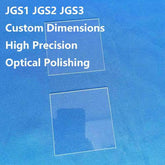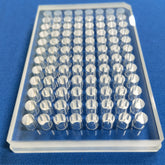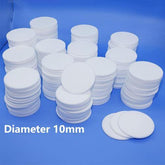The application of sapphire high-strength glass in window components
Sapphire high-strength glass is widely used as an auxiliary material in many products. Owing to its distinctive physical and chemical properties, it has demonstrated significant value across diverse fields. Primarily composed of aluminum oxide (Al₂O₃), sapphire is fabricated into a single-crystal structure through crystal growth processes and exhibits a Mohs hardness of 9. It also possesses excellent optical transmittance, high-temperature stability, and exceptional resistance to chemical corrosion. These characteristics render it an ideal material for key components such as radar windows, electro-optical windows, multi-functional integrated windows, and electro-optical pod windows.
Sapphire glass is also widely used in the field of optoelectronics. The output window of industrial laser equipment must be able to withstand continuous exposure to high-power laser beams. Sapphire material has a damage threshold of 15J/cm² at a light wavelength of 1064nm, which is more than 20 times that of ordinary optical glass. The plasma observation window in semiconductor manufacturing equipment uses sapphire sight glasses with a diameter of 200-300mm. These glasses are able to resist the erosion of corrosive gases and maintain stable optical performance. In the field of environmental monitoring equipment, deep-sea detectors utilize sapphire pressure-resistant windows with a thickness of 30mm, ensuring structural integrity in deep trenches and providing a clear observation channel for underwater cameras.

Advances in preparation technology have led to the development of sapphire high-strength glass in larger sizes and with composite functions. The diameter of sapphire crystals grown by the temperature gradient method (TGT) has reached 450mm, meeting the requirements of the new generation of optoelectronic systems. Breakthroughs in surface coating technology have facilitated the integration of multifunctional optical layers on sapphire windows, enabling concurrent implementation of visible-light anti-reflective coatings (400-700nm), laser protective filters (1064 nm), and radar-transparent films (Ka-band) within optoelectronic pod systems.
Advancements in material composite engineering have significantly extended the application frontiers of sapphire. The sapphire-diamond composite window fabricated via chemical vapor deposition (CVD) grows with single crystalline diamond films on sapphire substrates, achieving thermal conductivity up to 2000 W/(m·K) with direct applicability to high-power laser weapon systems. The gradient connection technology between sapphire and silicon carbide has successfully addressed thermal expansion mismatch in dissimilar materials. The development of flexible sapphire films has enabled 100μm-thick flexible sapphire to be applied to wearable optoelectronic devices.
Sapphire high-strength glass is experiencing increased popularity in the consumer sector. The sapphire material used in the smartphone camera’s protective cover plate has been shown to exhibit a significantly reduced scratch rate and an enhanced light transmittance compared to traditional glass. Following the enhancement of the surface glass of smartwatches to sapphire, the Mohs hardness test demonstrated an improvement in scratch resistance. As manufacturing costs decrease, sapphire is becoming a viable option for the automotive industry, particularly in the production of projection screens.

Sapphire high-strength glass is a key functional material that continues to expand in terms of both its application breadth and depth. From industrial equipment to consumer electronics, this “transparent armour” is playing a role. Sapphire glass is set to become a key material in modern science and technology thanks to the collaborative innovation in material design, preparation processes and application technologies.






